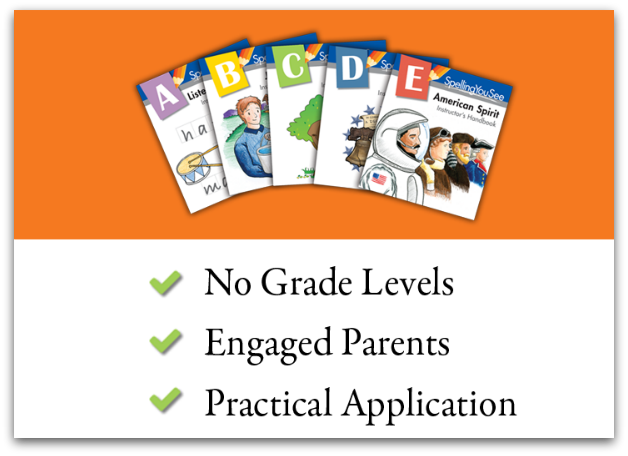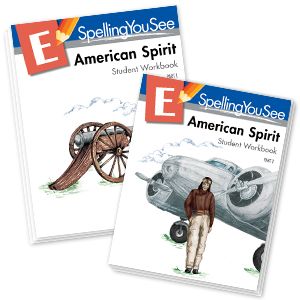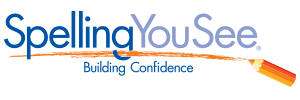There are currently 5 levels available in the Spelling You See program:
- Listen and Write (Level A)
- Jack and Jill (Level B)
- Wild Tales (Level C)
- Americana (Level D)
- American Spirit (Level E)
There are two more levels on the horizon:
- Ancient Achievements (Level F)
- Modern Milestones (Level G)

There are five developmental stages of spelling, according to Dr. Karen Holinga, who is the creator of Spelling You See. These stages are (you can read more about each stage on the Spelling You See website):
- Preliterate
- Phonetic
- Skill Development
- Word Extension
- Derivational Constancy
The idea behind Spelling You See is that a student must master one stage before moving on to the next. Because of this, there are no grade levels on the Spelling You See books. You can read more about each level and download sample lessons to help determine placement by visiting the Spelling You See website.

There are 36 lessons in each level of Spelling You See, and each lesson is broken down into 5 parts. While it is important that you and your child are consistent with spelling lessons, I found it a bit of a relief that the Instructor's Handbook states that it is okay to move along to the next lesson without completing the previous lesson. I don't know about you, but sometimes I get bogged down in finishing every last bit, even if life has interrupted and thrown us a bit off schedule, so it is reassuring to know that the ideas and concepts and words and patterns being taught will come up again in future lessons.
American Spirit (Level E) is designed for children who are in at least fourth grade, who read well, and who are moving along with spelling. A student new to Spelling You See should start here, in this level. The package comes with 2 Student Workbooks and a pack of erasable colored pencils ($30) and there is also an Instructor's Handbook ($14).
How exactly, then, does Spelling You See work?
This program has your student studying the patterns of spelling through the use of chunking, copywork, and dictation. Chunking is simply using a simple color coding system to mark various patterns in words: vowel chunks (such as "ou"), consonant chunks (such as "wh"), bossy r chunks (such as "ir"), tricky y guy (such as "baby"), endings (such as "ing"), and silent letters (such as the "b" in thumb).
In American Spirit, each lesson is centered around a single passage about people or events in American history. Because the same passage is used for a week, the student really gets a chance to internalize the words in the passage. Before any pencil work is completed for the day, you are instructed to read the passage to your student, and then read the passage slowly together, paying close attention to the words. Finally, you use the color coded chunking method to chunk the passage.
Copywork is used on days 1-3 of each lesson. The student is asked to copy portions of the same passage over each of these three days. However, if you have a student who is a slow writer or struggles with penmanship, you might find it comforting to know that you are instructed to have your child stop copying after 10 minutes, even if they're not finished. After the child finishes the copywork, they then mark their copywork passage with the color coded chunking described above.
Dictation is completed on days 4-5 of each lesson. The two days of dictation are slightly different from each other, but like the copywork days, you are instructed to stop after 10 minutes. On day 4, the "First Dictation", you read the passage slowly and watch your student write each word. You help them with capitalization and punctuation, and you also help them spell any words that they misspell. You correct these immediately, because you don't want incorrect spellings to stick in their heads. You want to discuss the different chunks that come up in the dictation as you work through the passage. On day 5, the "Second Dictation", the goal is for the student to write the passage as you dictate it, but with minimal help.

I used this program with Micah, my 4th grader. I found the instructions in the Instructor's Handbook to be very helpful and necessary; it really explained the program methods (in addition to including an answer key). Without it, I wouldn't have known exactly what to do. We followed the methods outlined above, so lessons took about 20-30 minutes, depending on how long we took to read the passage and chunk. For us, this was the only downfall of the program. With five children, it is difficult to regularly carve out that much time for spelling.
We both really liked the color/visual aspect of chunking in this program. I liked that it incorporated little lessons in American history into our spelling lesson, and I also love that it makes copywork and dictation fairly painless for me, the teacher. Micah is a decent speller, but he still doesn't enjoy the physical act of writing. Knowing that he could stop copywork and dictation after 10 minutes was an encouragement to him.
If you're looking for a sequential, colorful, and fun spelling program for your child, you should check out Spelling You See from Demme Learning.
If you're looking for a sequential, colorful, and fun spelling program for your child, you should check out Spelling You See from Demme Learning.



No comments:
Post a Comment